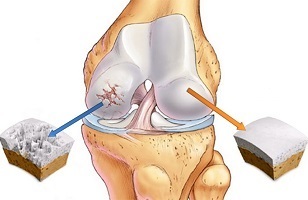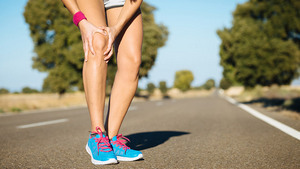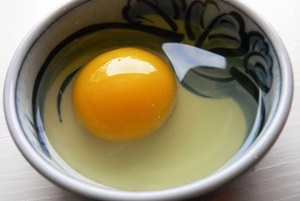
Osteoarthritis of the knee joint is one of the most common diseases of the joints and is the second most severe disease after coxarthrosis.
According to the latest research, the disease affects one in five adults in the world. In the article we will tell you what are the symptoms of this disease and how to properly treat it to avoid complications.Appearance reasons
Every day, a person's knee joints are stressed, because exercising while walking can withstand the whole body weight. Over time, the cartilage wears out, causing changes in the joints. That is why older people may experience osteoarthritis of the knee joints.
In addition, there is a risk group that includes people:
- overweight;
- suffering from osteoporosis;
- with hereditary diseases;
- old;
- work with heavy workload in special jobs;
- has metabolic diseases;
- micronutrient deficiency in the body;
- with spinal injuries;
- athletes.
We must not forget that the disease develops quite slowly, and if the main symptoms are found, it is very important to consult a doctor in time for advice.
This will prevent possible complications in the future, such as disability.
Symptoms of Osteoarthritis of the Knee
To accurately diagnose the disease, just look at the symptoms - they are very common in osteoarthritis. These include:

- Pain or discomfort after lying down (or trying to get up after sitting for a long time).
- Pain in the knees when standing for a long time.
- Burning sensation when climbing stairs.
- Nocturnal pain or anxiety after exercise.
- Feeling of weakness and "twisting" in the lower extremities.
One of the most important symptoms is pain and stinging in the knee.
At the same time, the disease itself does not appear "suddenly": such feelings can grow for months or years, and at first will be bothered only by increasing loads, and then the pain will be felt at rest.
However, it is important to remember that symptoms vary depending on the severity of the disease.
Let's take a closer look at each option.
I degree
Osteoarthritis of this degree is almost asymptomatic, but there are a number of factors that are characteristic of this stage of the disease:
- feeling tired in the limbs;
- Decreased mobility usually occurs after sleep.
If there is pain, it is almost invisible. It is very difficult to diagnose the disease at this stage, so it is impossible to do without X-rays: osteoarthritis will manifest itself as a small irregularity on the surface of tissues and bones.
II degree
At this "stage" the symptoms are more pronounced. The pain may appear even with a light load on the legs, and over time, such feelings may appear with a simple movement. Anxiety disappears only after a long rest.
Additionally:
symptoms such as- compression while moving;
- changes in the bones in the joint;
- synovitis;
- inability to bend the leg.
III degree
A characteristic feature of this degree is severe pain that no longer depends on the load: the joints can be restless at night when there is no movement.
Mobility is also impaired - a person cannot bend his leg at the knee. Sensitivity to air can also be observed.
Principles of diagnosis and additional treatment

After listening to the doctor, the doctor will examine the appearance of the knee and assess its mobility. After that, the patient will be sent for an X-ray examination, and during the treatment can be taken several pictures that allow to assess the dynamics of the development of osteoarthritis. In some cases, MRI or tomography is prescribed.
If research is required to correctly identify the underlying cause of osteoarthritis and differentiate it from other diseases with similar symptoms.
Treatment generally includes:
- Drug treatment.
- Massage and manual treatment.
- Surgical intervention.
- Sports therapy and other methods of rehabilitation therapy.
The main goals of treatment are:
- pain relief;
- garden apparatus and restoration of destroyed cartilage;
- Increased range of motion in the joint.
Massage procedures, physical therapy and even proper nutrition are important. If you see a doctor too late or none of the above methods help you, surgery will be prescribed: endoprosthesis installation.
Treatment of osteoarthritis - choice of methods and means
Currently, there are groups of drugs prescribed for the treatment of osteoarthritis at an early stage:
- NSAIDs - non-steroidal anti-inflammatory drugs;
- chondroprotectors;
- medicated ointments;
- compressor products.
NSAIDs are aimed at relieving pain and inflammation. And only after the pain syndrome subsides can additional treatment be started.
Doctors usually prescribe hormonal medications if the use of non-steroidal anti-inflammatory drugs has not worked, especially if the disease is progressing.
However, due to a number of side effects, it should be remembered that such drugs are prescribed only during the disease - in the case of accumulation of fluid inside the joint. The solution is injected no more than once in 10 days.
The only group of agents that directly affect the cause of osteoarthritis are chondroprotectors. They are especially effective in the early stages.
Hyaluronic acid, which is injected into the joint in the early stages, is also very effective. This procedure is not the cheapest, but it helps to erode the cartilage surface.
When osteoarthritis is detected, ointments are also prescribed - it also reduces pain and eliminates inflammation.
How traditional medicine can help
It should be noted at once that you should not use only traditional medical methods - they should be used only in addition to medical treatment.
Here are some things that can help with osteoarthritis of the knee:
Dandelion flowers
You should eat 5 dandelion flowers daily, be sure to rinse with boiled water. You can also make tinctures: take 5 dark glass bottles, fill 50% with flowers, fill the container around your neck with triple cologne. Insist for a month, then wipe your knees with the infusion.
Lapping

It should be rubbed into the knee joint regularly.
To prepare such a composition is very simple: take an egg yolk, mix it with 1 tbsp. l. turpentine, add 1 tsp. Apple cider vinegar. All ingredients should be mixed and left overnight.
Lubricate your knees every night and put a woolen scarf on them.
In addition, it is very important to wash the applied mixture thoroughly in the morning. You should use this method for 2-3 weeks to eliminate the symptoms.
burdock
According to folk remedies, you should stick 3-4 large burdock leaves on a painful knee and wrap them with a bandage. Repeat this manipulation for at least a week to reduce pain. To increase the effect, you should lubricate the joints with cinquefoil oil.
Carnation Water
Soak a piece of water in the juice and place it on the affected knee. After an hour, brush with vegetable oil. Repeat the procedure for a week.
Harpagophytum Root
Take 2 tablespoons. l. means pour into a thermos, pour 1 liter of boiling water, leave for two hours. Take at least 3 cups warm a day.
Choosing knee pads for osteoarthritis
Often, in the case of osteoarthritis of the knee joint, it is recommended to wear special knee pads that both reduce the feeling of discomfort and have a therapeutic effect. Typically, when used for a short period of time, you will see the following improvements:
- the inflammatory process is reduced;
- swelling disappears;
- painkiller;
- reduces pressure on the joints;
- The functioning of the musculoskeletal system is stable.
It is very important to choose the right model that will be effective when worn. To do this, first find out which knee pads are available:
Open
- .It is important for those who feel pain after any injury or minor pain.
- Elastic productswith hardeners. This type of knee pads is more suitable for those who have pain when bending, climbing or descending stairs.
- Open-shapedadjustable tension knee pads. Such products are ideal after surgery.
- Closed type- used when the source of pain is not clear, ie not concentrated anywhere. Allows you to minimize stress on joints The
- magnetic appearance of the knee padis characterized by the presence of a special magnet, which has a warming effect and improves blood circulation.
- Hinged.is a universal choice. Injury is used to minimize pain after osteoarthritis.
In addition to the type, you should also consider the material from which the knee pad is made. Thus, such items can be made from:
- Animal fur.These products heat, absorb moisture, reduce inflammation and improve blood circulation in the tissues.
- Polyester.These knee pads made of artificial fabric are very comfortable, reliable, but do not heat up and are very expensive.
- cotton.It is well worn and water resistant. However, there are also disadvantages: elasticity and lack of fragility in use.
- nylon.Knee pads made of this material are considered the most suitable and durable for the body. But there is a downside - it is an artificial material.
- Neoprene.Although it is an artificial fabric, this material is elastic and has a warming effect. There is also a drawback - wearing such knee pads can cause allergies.
But it's important to choose the right knee pads as well as use them. Here are some important tips to follow:
- you should not wear them for more than three hours a day;
- The duration of wear depends on the degree of osteoarthritis - the doctor will tell you more about it;
- If you have an allergy, you should immediately consult a doctor who will prescribe another dressing;
- It is not possible for the agent to compress the compounds strongly;
- Wash pillows by hand, water temperature should not exceed +40 degrees.
As a result, it should be noted that a healthy lifestyle should not be neglected - in this case, the body will work as it should. If you feel pain in the joints, you should immediately consult a doctor to make a correct diagnosis.

























